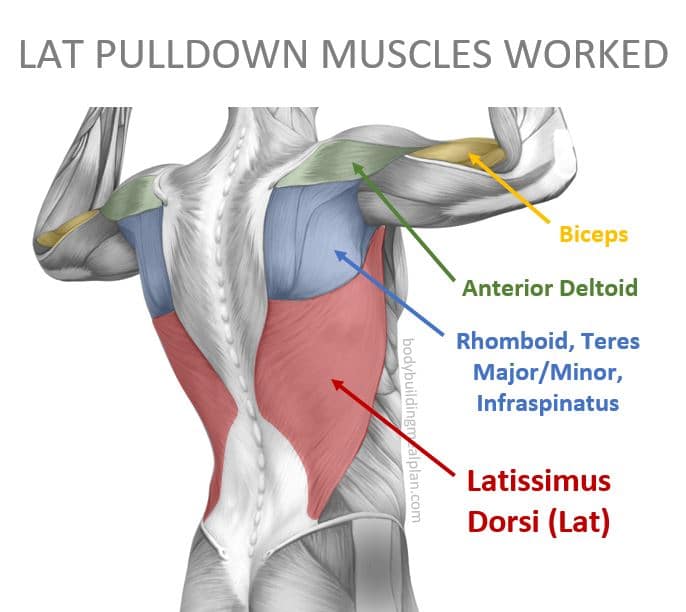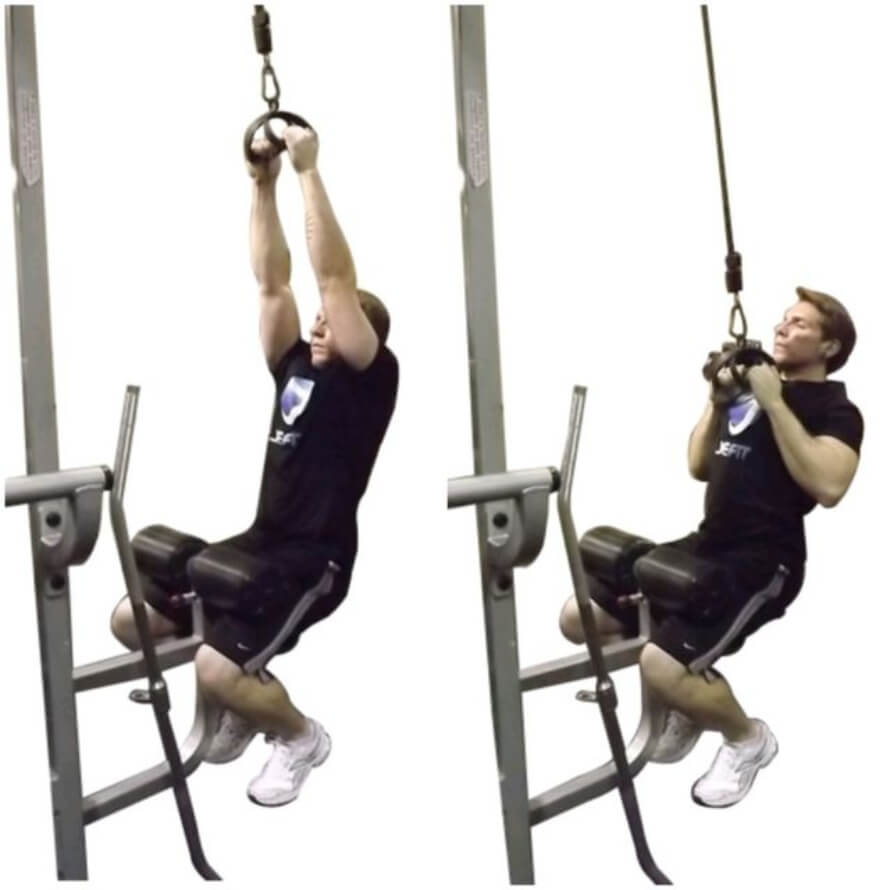What are Lat Pulldowns and How do They Benefit You?
Lat pulldowns are a popular strength training exercise that primarily targets the back muscles, particularly the latissimus dorsi, often referred to as “lats.” This exercise is performed using a cable machine with a lat pulldown bar, and it involves pulling the bar down towards your chest while seated. By incorporating lat pulldowns into a workout routine, individuals can experience numerous benefits, such as improved posture, increased upper body strength, and enhanced muscle definition. These advantages make lat pulldowns an essential exercise for anyone looking to build a strong and balanced physique.
The Anatomy of a Lat Pulldown: Muscles Involved
Lat pulldowns are a compound exercise that primarily targets the latissimus dorsi, a large, fan-shaped muscle located on the back. The latissimus dorsi is responsible for extending, adducting, and internally rotating the shoulder joint, making it a crucial muscle for upper body strength and movement. During a lat pulldown, the lats work to pull the bar down towards the chest, engaging other muscles in the process.
In addition to the latissimus dorsi, several secondary muscles are involved in a lat pulldown. These muscles include the biceps brachii, which assists in elbow flexion; the triceps brachii, which extends the elbow; the rhomboids, which retract the shoulder blades; and the deltoids, particularly the posterior head, which helps with shoulder extension and transverse extension. By engaging these muscles, lat pulldowns contribute to overall upper body strength, stability, and muscular balance.
How to Perform a Lat Pulldown: Proper Technique and Form
To maximize the benefits of lat pulldowns and ensure the targeted muscles are effectively engaged, it is crucial to maintain proper technique and form throughout the exercise. Follow these steps to perform a lat pulldown:
- Adjust the seat height and knee pad to ensure a comfortable and secure position. Your knees should be placed under the knee pad, and your feet should be flat on the floor or the platform.
- Grasp the lat pulldown bar with a wide grip, using an overhand (pronated) grip. Your hands should be spaced slightly beyond shoulder-width apart. Maintain a neutral spine and engage your core muscles.
- Pull the bar down towards your chest, keeping your elbows close to your body and your shoulders down (avoid shrugging). As you pull the bar down, squeeze your shoulder blades together and focus on engaging your lats.
- Once the bar reaches your chest (or just above it), pause for a moment to squeeze and activate the targeted muscles. Then, slowly and controlled, return the bar to the starting position, extending your arms without fully locking your elbows.
- Repeat the movement for the desired number of repetitions, maintaining proper form and technique throughout the set.
Incorporate images or diagrams to visually demonstrate the exercise and ensure proper understanding of the steps involved.
Variations of Lat Pulldowns: Targeting Different Muscle Groups
Lat pulldowns offer various grip and hand position variations, allowing you to target different muscle groups and address specific fitness goals. Here are some common lat pulldown variations and their benefits:
Wide-Grip Lat Pulldowns
A wide grip targets the latissimus dorsi more intensely, emphasizing the outer portion of the muscle. This variation also engages the upper back muscles, such as the trapezius and rhomboids, to a greater extent. However, a very wide grip may put excessive strain on the shoulder joint, so it’s essential to find a comfortable and safe grip width.
Narrow-Grip Lat Pulldowns
A narrow grip targets the inner portion of the latissimus dorsi and involves the biceps more significantly. This variation may also help improve grip strength. However, using too narrow of a grip may reduce the engagement of the upper back muscles.
Reverse-Grip Lat Pulldowns
A reverse (underhand) grip targets the biceps and brachioradialis more effectively, in addition to engaging the latissimus dorsi and upper back muscles. This grip variation can help build a stronger grip and improve overall pulling strength. However, it may put more stress on the wrists and forearms, so it’s crucial to warm up properly and gradually increase the weight.
When choosing a lat pulldown variation, consider your fitness goals, current strength levels, and any existing muscle imbalances. Incorporating a variety of grips and hand positions can help ensure a balanced and comprehensive back workout, reducing the risk of injury and promoting optimal muscle development.
Incorporating Lat Pulldowns into Your Workout Routine: Tips and Recommendations
To maximize the benefits of lat pulldowns and effectively integrate them into your workout routine, consider the following tips and recommendations:
Frequency
Perform lat pulldowns 1-3 times per week, allowing adequate recovery time between sessions. Incorporate them into a balanced upper body or back-focused workout.
Volume
Aim for 3-5 sets of 8-12 repetitions per set. Adjust the weight to maintain proper form throughout the entire range of motion. This rep range is suitable for both strength and hypertrophy gains.
Intensity
Gradually increase the weight as you become stronger, focusing on controlled movements and progressive overload. This can be achieved by adding more weight, performing more repetitions, or completing additional sets.
Common Questions
How many sets and reps should I perform for lat pulldowns? Aim for 3-5 sets of 8-12 repetitions per set. This rep range is suitable for both strength and hypertrophy gains. Adjust the weight to maintain proper form throughout the entire range of motion.
Progression
To track progress, record the weight, sets, and reps for each workout. Aim to increase one or more of these variables over time, ensuring continuous improvement and muscle development.
By incorporating these tips and recommendations, you can effectively integrate lat pulldowns into your workout routine, targeting the back muscles and promoting overall upper body strength and muscular development.
Common Mistakes and Misconceptions: Avoiding Pitfalls in Lat Pulldowns
Lat pulldowns are an effective strength training exercise, but common mistakes and misconceptions can hinder progress and even lead to injuries. Here are some common pitfalls to avoid:
Overemphasis on Weight
Using too much weight can compromise form and reduce the effectiveness of the exercise. Focus on controlled movements and progressive overload, gradually increasing the weight as strength improves. Maintain proper form throughout the entire range of motion.
Neglecting Form
Proper form is crucial for engaging the targeted muscles and preventing injuries. Ensure that the shoulders are down and away from the ears, the core is engaged, and the back remains straight throughout the exercise. Avoid swinging or using momentum to lift the weight.
Limited Range of Motion
Performing partial repetitions or limiting the range of motion can reduce the effectiveness of the exercise. Aim to pull the bar down to the upper chest or just below the chin, ensuring a full range of motion and maximizing muscle engagement.
Inconsistent Tempo
Maintaining a consistent tempo, both during the concentric (pulling) and eccentric (releasing) phases, can help ensure proper form and muscle engagement. Aim for a controlled, deliberate tempo, avoiding quick, jerky movements.
Ignoring the Importance of Progressive Overload
Progressive overload is essential for continued strength and muscle development. Gradually increase the weight, sets, or reps over time, ensuring that the muscles are challenged and continue to adapt.
By being aware of these common mistakes and misconceptions, you can optimize your lat pulldown technique, ensuring proper form, muscle engagement, and progress towards your fitness goals.
Comparing Lat Pulldowns to Other Back Exercises: Which is Best for You?
Lat pulldowns are an effective back exercise, but they are not the only option available. Comparing lat pulldowns to other popular back exercises, such as pull-ups, rows, and deadlifts, can help you determine which exercise best suits your fitness goals and preferences. Each exercise offers unique advantages and disadvantages, emphasizing the importance of a balanced workout routine.
Pull-ups
Pull-ups are a compound exercise that targets the latissimus dorsi, biceps, and forearms. They require a pull-up bar and involve pulling your body up until your chin clears the bar. Pull-ups can be more challenging than lat pulldowns due to the increased body weight resistance. However, they offer the advantage of training the entire upper body and core stabilizers, as well as improving grip strength.
Rows
Rows are a versatile exercise category that includes bent-over rows, seated cable rows, and inverted rows. Rows primarily target the middle and upper back muscles, such as the trapezius, rhomboids, and teres major, as well as the biceps. They can help improve posture and reduce the risk of shoulder injuries. Rows can be a suitable alternative for those with limited access to a lat pulldown machine or for those looking to add variety to their back workouts.
Deadlifts
Deadlifts are a compound exercise that targets multiple muscle groups, including the back, legs, and core. They involve lifting a barbell or other weighted object off the ground and returning it to the starting position. Deadlifts can help improve overall strength, power, and functional fitness. However, they may not isolate the back muscles as effectively as lat pulldowns or pull-ups. Proper form and technique are crucial for deadlifts to prevent injuries.
Incorporating a variety of back exercises into your workout routine can help ensure a balanced and comprehensive back workout, reducing the risk of injury and promoting optimal muscle development. Choose exercises based on your fitness goals, equipment availability, and personal preferences. Remember to prioritize proper form and technique over weight or repetitions for safe and effective muscle engagement.







